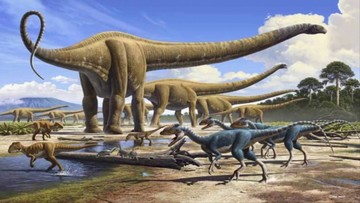Triceratops
Dinosaur Species | Species
Triceratops is a genus of herbivorous ceratopsid dinosaur that first appeared during the late Maastrichtian stage of the late Cretaceous period, about 68 million years ago (mya) in what is now North America. It is one of the last known non-avian dinosaur genera, and became extinct in the Cretaceous–Paleogene extinction event 66 million years ago. The term Triceratops, which literally means "three-horned face", is derived from the Greek τρί- (tri-) meaning "three", κέρας (kéras) meaning "horn", and ὤψ (ops) meaning "face". Triceratops has been documented by numerous remains collected since the genus was first described in 1889, including at least one complete individual skeleton. Paleontologist John Scannella observed: "It is hard to walk out into the Hell Creek Formation and not stumble upon a Triceratops weathering out of a hillside." Forty-seven complete or partial skulls were discovered in just that area from 2000 to 2010. Specimens representing life stages from hatchling to adult have been found. As the archetypal ceratopsid, Triceratops is one of the most popular dinosaurs, and has been featured in film, postal stamps, and many other types of media.
Subject ID: 13895
MoreTriceratops is a genus of herbivorous ceratopsid dinosaur that first appeared during the late Maastrichtian stage of the late Cretaceous period, about 68 million years ago (mya) in what is now North America. It is one of the last known non-avian dinosaur genera, and became extinct in the Cretaceous–Paleogene extinction event 66 million years ago. The term Triceratops, which literally means "three-horned face", is derived from the Greek τρί- (tri-) meaning "three", κέρας (kéras) meaning "horn", and ὤψ (ops) meaning "face". Triceratops has been documented by numerous remains collected since the genus was first described in 1889, including at least one complete individual skeleton. Paleontologist John Scannella observed: "It is hard to walk out into the Hell Creek Formation and not stumble upon a Triceratops weathering out of a hillside." Forty-seven complete or partial skulls were discovered in just that area from 2000 to 2010. Specimens representing life stages from hatchling to adult have been found. As the archetypal ceratopsid, Triceratops is one of the most popular dinosaurs, and has been featured in film, postal stamps, and many other types of media.
Subject ID: 13895
Subject ID: 13895
